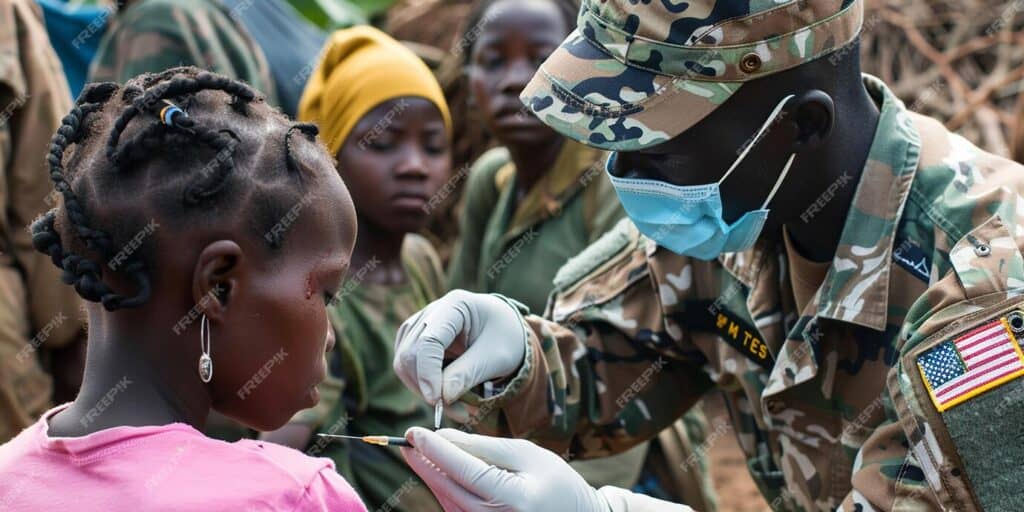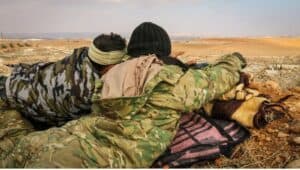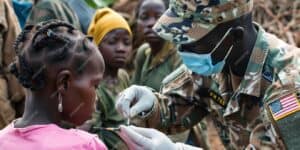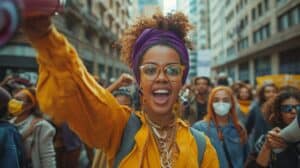
Reports on Conflicts in Congo: Stay Updated
The UN shared a sad update about the Congo. A record 6.9 million people were displaced within the country by October 2023.1
This number shows how big the humanitarian crisis is. The conflict between the military and groups like the M23 and ADF has damaged eastern DRC after the violent election in December 2023.
The M23 is a rebel group mostly made up of Tutsis. They are said to have help from Rwanda and Uganda. The ADF is connected to ISIS.
There are over 100 groups fighting in the area.1 This fighting has gotten worse since February 2024, causing great pain. Although the violence is mostly in the east, the troubled election added to problems across the country.
Violence in the Congo has been killing people for over 30 years.1 Since 1996, about six million have died because of the fighting.1
The Second Congo War and its fallout may have killed over three million by 2004.

Key Takeaways
- The Democratic Republic of Congo is facing a record-breaking humanitarian crisis, with over 6.9 million internally displaced people as of October 2023.
- Violent clashes between the military and rebel groups like M23 and ADF have escalated in the aftermath of the country’s flawed elections in December 2023.
- Conflict in eastern DRC since 1996 has resulted in approximately six million deaths, with the Second Congo War and related humanitarian crisis claiming over three million lives by 2004.
- The ongoing violence in the region has globalized the conflict, with the U.S. imposing restrictions on imports of “conflict minerals” from the DRC.
- The humanitarian disaster in the DRC continues to deepen, underscoring the urgent need for a peaceful resolution to the longstanding conflict.
Understanding the Origins of Conflict in the Democratic Republic of Congo
The Democratic Republic of Congo (DRC) has been facing violence for a long time, especially in the east since 1994 after the Rwandan Genocide.2
About two million Hutu people escaped to the DRC then, and some formed armed groups there.2 This led to the First Congo War in 1996, causing around six million deaths.12
The Legacy of the Rwandan Genocide
The Rwandan Genocide in 1994 was a tragedy where Hutu extremists killed one million Tutsis and moderate Hutus.2
After the genocide, nearly two million Hutu people left Rwanda for Congo. They stayed in camps there, especially in the North and South Kivu provinces.2
Some of the people who came were Hutu extremists. This added to the tensions that led to the First Congo War.
The First Congo War (1996–1997)
The First Congo War started in 1996 because of Hutu armed groups in the east and Tutsi forces countering them.12
Other countries started to get involved, making the fighting worse. This began the DRC’s era of outside involvement in its conflicts.
The Second Congo War (1998–2003)
The Second Congo War began in August 1998 and was incredibly deadly.
By 2004, over three million people may have died.1
It involved many rebel groups and foreign armies, making the situation even more unstable in the DRC.2
| Key Events | Timeline | Impact |
|---|---|---|
| Rwandan Genocide | 1994 | Approximately two million Hutu refugees fled to the DRC, including Hutu extremists who began organizing militias. |
| First Congo War | 1996-1997 | Led to approximately six million deaths in the DRC. |
| Second Congo War | 1998-2003 | Death toll may have reached over three million people by 2004. |
| M23 Rebel Group | 2012-2013 | Became a significant force in eastern DRC, with accusations of backing by Rwanda. |
Key Players in the Ongoing Conflicts
In the Democratic Republic of Congo (DRC), many armed groups and militias are active.
They play a big part in the area’s long history of violence.1 One key group, the M23, formed in the early 2000s. They are mainly ethnic Tutsis.
The March 23 Movement (M23)
From 2012 to 2013, M23 grew powerful in eastern DRC,1 with the government in Kinshasa saying Rwanda supported them.
In response, the UN set up a special force to help fight M231. Despite this, Rwanda’s involvement made things tense between them and Kinshasa.
The Allied Democratic Forces (ADF)
The ADF is another group in the DRC, linked to the Islamic State. They have attacked civilians, leading to many deaths and forced child soldier recruitment.3
The ADF’s actions have made the eastern DRC even more unstable and have worsened the area’s humanitarian crisis.
Other Rebel Groups and Militias
There are over 100 armed groups in the DRC, beyond M23 and ADF. Most are after valuable minerals like gold.
These groups, some from other nations, are involved in terrible crimes, such as the trafficking in women and children and the sexual violence.3
Their actions make security in the eastern DRC very precarious.
Reports on Conflicts in Congo: The Impact on Civilians
Displacement and Humanitarian Crisis
The conflicts in the Democratic Republic of Congo (DRC) have hit civilians hard. By October 2023, the UN says 6.9 million people were forced from their homes there.1
Since 1996, fighting in eastern DRC has led to about six million deaths.1 The Second Congo War, ending in 2004, caused more than three million deaths.1
These numbers show just how much people suffer because of ongoing violence.
Human Rights Violations and Atrocities
The situation in the DRC is worsened by serious human rights abuses and atrocities. M23, a rebel group, made mostly of Tutsis, rose to power in 2012-2013 in eastern DRC.1
Chinese companies own most foreign mines in DRC. The Congolese army guards these mines, causing concerns about exploitation.1
In July 2022, it was revealed that some mines use child labor and other illegal practices.1
The crises in the DRC have forced many from their homes and ended many lives. They have also brought about widespread abuse of human rights.
This ongoing crisis greatly affects the people living there.
The Role of Foreign Actors and Interests
The Democratic Republic of Congo (DRC) faces ongoing conflicts influenced by foreign actors. These actors chase after economic benefits in the region.
Rwanda, Uganda, China, and the United States contribute to these conflicts with their own objectives.
The Involvement of Rwanda and Uganda
Rwanda stands accused of backing the M23 rebel group, a key figure in the DRC’s conflicts. Rwanda’s role started in the 1990s, during the First Congo War.
At that time, Rwandan forces and local militias moved into Zaire to combat Hutu militias from Rwanda.
This activity aimed to create a buffer zone between DRC and Rwanda to keep away from Hutu groups.1
China’s Economic Interests and Military Support
Congo’s rich natural resources brought global attention and conflict to the eastern DRC.1 Previously, U.S. companies dominated cobalt mining in the region.
But during Obama and Trump’s presidencies, these mines were mostly sold to Chinese companies. Now, Chinese firms, linked to Beijing, lead in cobalt, uranium, and copper mining.
The Congolese army often guards these Chinese-owned sites. There are also claims that Chinese money meant for DRC’s infrastructure was redirected to Joseph Kabila and others, sparking international concerns.1
Chinese workers were harmed in a violent robbery in 2023, showing the risks involved in the region.1
The United States and International Efforts
The United States and the world have shown some involvement in DRC’s struggles, but it has been off and on.4
Back in 2013, the UN Security Council allowed offensive action to support the Congolese army against the M23. This effort was part of the UN Mission’s strategy to stabilize the area.
The EU also put sanctions on top DRC security officials for blocking peace efforts and for human rights abuses.4
Still, the support from international bodies has varied over time.4 This inconsistency has played a part in the region’s continuing violence.
It underscores the importance of aligning strategies and interests to aid DRC’s stability.

Recent Developments and Escalations
The conflict in eastern Congo could grow and spread, making the region more dangerous.1
In October 2023, the UN saw a record number of 6.9 million displaced people in the Democratic Republic of Congo.1
Since 1996, around six million people have died from the conflict in eastern DRC.1
The death toll from the Second Congo War and its resulting crisis by 2004 was over three million people,1 with estimates suggesting another three million deaths between 2002 and 2003.1
The risk of a wider conflict drawing in more countries is high.5 Within the DRC, 7.1 million are displaced, and 23.4 million face hunger,5 with 1 in 4 being food insecure.5
The aid plan for the DRC is barely funded, but the UK pledged $126 million to help for three years.5
Only 16 per cent of the $2.6 billion needed for 2024 has been covered,6 but the United States gave over $294 million for the DRC’s humanitarian response.6
The eastern DRC has suffered decades of violence and displacement, leading to ongoing insecurity and a rise in gender-based violence.6
Five countries, including the DRC, now work together on certifying minerals from November 28, 2023.6
While Angola’s and Rwanda’s presidents are trying to improve relations, tension between the DRC and Rwanda is high due to clashes involving M23 and FARDC forces.6
Conclusion: Reports on Conflicts in Congo: Stay Updated
In the Democratic Republic of Congo (DRC), conflicts are tearing the country apart. As of 2023, more than 6.9 million people are displaced within its borders.
The situation is making the humanitarian crisis even worse. Violent national elections in December 2023 have increased the violence.
The conflict involves the military and rebel groups such as M23 and ADF.
The DRC is hit the hardest by not having enough food. About 1 in every 4 people in the DRC live with hunger and malnutrition.5
The help needed is very underfunded, with only 14% of the funding it requires.5 This shows how much more help the international community needs to give.
Efforts to bring peace, like the Luanda process, are ongoing. The Southern Africa Development Community (SADC) Mission has been sent in.
However, the conflict’s roots are deep. It involves many armed groups and external interference.
This mix keeps the violence and instability going, problems that have been there for a long time. It makes the region very volatile.75
Related read: African-social-issues-poverty-inequality-more
Source Links
- https://www.cfr.org/global-conflict-tracker/conflict/violence-democratic-republic-congo
- https://www.aljazeera.com/news/2024/2/21/a-guide-to-the-decades-long-conflict-in-dr-congo
- https://www.hrw.org/world-report/2024/country-chapters/democratic-republic-congo
- https://africacenter.org/spotlight/role-external-actors-drc-congo-crisis-sadc-au-icglr-un-eu/
- https://press.un.org/en/2024/sc15646.doc.htm
- https://press.un.org/en/2024/sc15677.doc.htm
- https://www.amnesty.org/en/location/africa/east-africa-the-horn-and-great-lakes/democratic-republic-of-the-congo/report-democratic-republic-of-the-congo/





